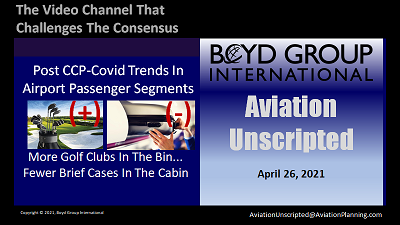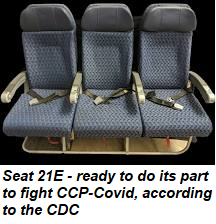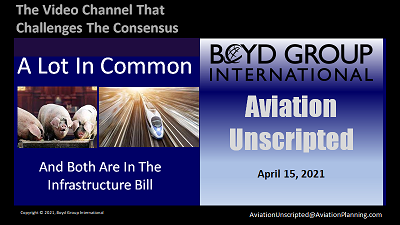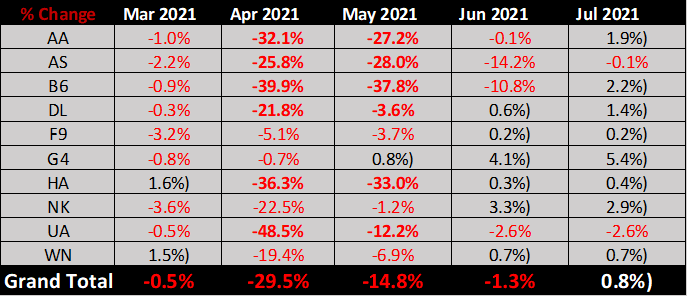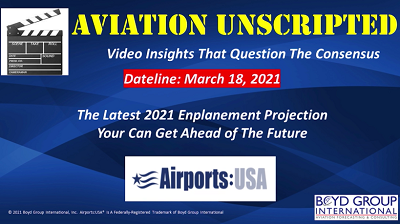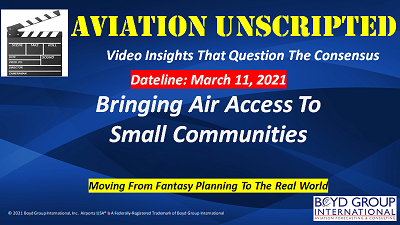Summer Traffic Spike – It’s Restructuring. Not Recovery To Pre-CCP-Covid.
We’ve noted in the latest Touch & Go newsletter sent to our clients & friends that the now-in-progress spike in air passenger growth may be only a bubble on the way to a new role for air transportation in the USA.
Comparing 2021 Planned Capacity To 2019… As of today, the airline industry has not yet fully adjusted the schedule patterns for July and August… plus, it is highly optimistic that September will remain at 8% more seats offered than in 2019.
Clouds On The Horizon. It is logical to accept that June will be in the @80% range of what was offered in 2019. July, too. However, it is really optimistic to project that air traffic volumes will exceed 2019 by the 4th quarter.
First, business traffic most likely will see no rebound to the pre-CCP-Covid levels. How much it will rebound will depend on the fundamental changes in the basic foundation of business communication systems that have been experienced in the last 12 months.
Second, it is an open question regarding the drivers of the summer travel spike. It may be a bubble of demand, or it may be the indication that in the future leisure demand will be a larger percentage of revenue opportunities for the airline industry. That would indicate more vulnerability to economic shifts that affect disposable income and investment income.
Finally, air travel is entirely dependent on available dollars – both personal and business. That’s factor which apparently nobody wants to consider right now.
Planed Economic Policies Are Not Encouraging. Let’s state the facts: The economic view from 30,000 feet up isn’t real encouraging. Virtually every economic policy coming out of Washington is based on wealth reduction (taxes) or wealth suppression (social experiments that deter free and open discussion of issues and are openly aimed at reduction in commerce.) Then there are open trendy attacks on supply of fuel – prohibiting exploration and closing pipeline projects will only make travel – and the cost of living – more expensive.
This stuff does not encourage travel spending – particularly when higher taxes will ultimately eat up discretionary spending – regardless of usual political promises to the contrary.
It is understood that these conclusions might be politically incorrect, but it’s what’s on the table and it is clear and obvious.
The next four weeks will be very interesting – if bookings remain strong for post-Labor Day travel that will determine how rapidly we will attain “full” enplanements – this being air passenger traffic that the new economy will support.
Stay tuned.
___________________
Another Sacred Tome Questioned
There is an increasing number of political and social areas that unfortunately are being relegated to the “not to be questioned” category, for fear of being pilloried or burned at the stake of consensus thinking.
There are things we mere mortals must not question for fear of being publicly exposed as a socially dangerous heretic.
 In the early 1950s, “everybody knew” that atomic power and nuclear energy would deliver incredible economic benefits… nearly free electrical power… nearly free heat in cold regions… all sorts of magic. It was the dogma.
In the early 1950s, “everybody knew” that atomic power and nuclear energy would deliver incredible economic benefits… nearly free electrical power… nearly free heat in cold regions… all sorts of magic. It was the dogma.
It even extended to official and nonsensical malarkey regarding the ease avoiding the dangers in the event of nuclear attack. Folks who attended grade school in the 1950s can remember “duck and cover” exercises in the classroom. Simple. If you see a nuclear flash, kids, just duck under your desk. And, if you’re outside, just cover yourself with anything – even a newspaper – to be safe.
Not kidding. The government actually produced cutesy public service announcement films about this stuff. Atomic power was the unquestioned future, and indeed a copy of the financial section of the New York Times was sufficient to ward off being turned into a crispy critter if the Commies attacked.
‘Course, in the case of a real nuclear attack this would likely delay your journey to the Pearly Gates by at least two to three milliseconds.
 Today, we still have a range of sacred dogmas that are not to be questioned. Those who do so are immediately and confidently attacked as “non-believers” or worse. The masses are tacitly instructed to do so, automatically.
Today, we still have a range of sacred dogmas that are not to be questioned. Those who do so are immediately and confidently attacked as “non-believers” or worse. The masses are tacitly instructed to do so, automatically.
Okay. We’ve now stepped over the line, and possibly stepped into a pile of accepted dogma.
Last week’s Aviation Unscripted has dared to discuss the concept of “sustainability” in regard to at least one accepted “green” approach to the future. The reality is that some of the accepted “green” alternatives are anything but – and are socially damaging.
We included this in our last Touch & Go, so if you missed it there click here to take a factual gander at one “accepted” green solution that is anything but.
If you haven’t viewed it, click here.
Leadership means questioning the norm. That’s not what’s going on with a lot of “sustainability” assumptions.

